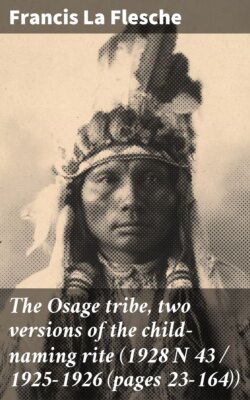Читать книгу The Osage tribe, two versions of the child-naming rite (1928 N 43 / 1925-1926 (pages 23-164)) - Francis la Flesche - Страница 4
На сайте Литреса книга снята с продажи.
INTRODUCTION
ОглавлениеTable of Contents
The two versions of the Osage Child-naming Rite recorded in this volume were obtained with considerable difficulty, owing to the reluctance of the people to speak of the sacred rites that were formulated by the Ni´-ḳa Xu-be, Holy Men, of long ago. This unwillingness to speak of the tribal rites, excepting in the prescribed ceremonial way, arose from a sense of reverence for things sacred and from the belief that within the rites, and in the articles dedicated to religious use, there resides a mystic power which could punish, by supernatural means, the persons who speak irreverently of the rites and put to profane use the symbolic articles.
In the early part of the life of the Osage, according to tradition, the people kept together for protection and moved about without tribal or gentile organizations, a condition which they termed “gani´-tha,” which may be freely translated as, without law or order.
It was in those days that a group of men fell into the habit of gathering together, from time to time, to exchange ideas concerning the actions of the sun, moon, and stars which they observed move within the sky with marvelous precision, each in its own given path. They also noticed, in the course of their observations, that the travelers in the upper world move from one side of the sky to the other without making any disturbances in their relative positions, and that with these great movements four changes take place in the vegetal life of the earth which they agreed was effected by the actions of some of the heavenly travelers. These seasonal changes they named Be, Do-ge´, Ṭoⁿ, and Ba´-the (Spring, Summer, Autumn and Winter).
The delving into the mysteries of the universe by this group of men, which was carried on for a long period of time, was primarily for the purpose of finding, if possible, the place from which comes all life.
The seasonal changes upon the earth which appear to accompany the movements of the sun and other cosmic bodies suggested to these men the existence between sky and earth of a procreative relationship, an idea which fixed itself firmly in their minds. It fitted their notion that the earth was related to and influenced by all of the great bodies that move around within the sky. However, they were not satisfied that these celestial bodies move without the guidance of some governing power, and they continued their search and their discussions. Then, in course of time, there crept into the minds of these men, who became known as the “Little Old Men,” the thought that a silent, invisible creative power pervades the sun, moon and stars and the earth, gives to them life, and keeps them eternally in motion and perfect order. This creative power which to their minds was the source of life they named Wa-ḳoⁿ´-da, Mysterious Power, and sometimes E-a´-wa-woⁿ a-ka, The Causer of Our Being.
These ideas are given expression in that part of the child-naming rite where the initiated members of two gentes are first called to enter the house in which the ceremonies are to take place. One of these gentes, the Ṭsi´-zhu Wa-shta-ge, Peaceful Ṭsi´-zhu, represents the sky with its sun, moon, and stars, and the other, the Wa´-ṭse-ṭsi Wa-shta-ge, Peaceful Wa´-ṭse-ṭsi, represents the earth with its waters and dry land. The house itself then becomes a symbol of the sky which encompasses the sun, moon, stars, and the earth. Thus the house, the two gentes and all the others who enter it to take part in the rite become, collectively, a symbol of the universe wherein life manifests itself by taking on an infinite variety of bodily forms. The whole ceremony is an expression of a longing desire that Wa-ḳoⁿ´-da who dwells in the universe will favor the little one who is to be named with a long life and an endless line of descendants.
The men who recorded the two versions of the Osage child-naming rite were typical full-blood Indians, neither of them spoke the English language, and nothing in all that they have given suggests foreign influence. Wa-xthi´-zhi (pl. 1) was a man of an inquiring mind. He did not hesitate to ask of his initiators the meaning of the parts of the rituals which he did not fully understand. He learned much from his father, who was well versed in the ancient tribal rites.
Shoⁿ´-ge-moⁿ-iⁿ (pl. 2) did not have these advantages, but he had a retentive mind and what he committed to memory of the rites was sufficient to him. He did not insist upon being informed as to the meaning of the parts of the rites that were obscure to him.
I am indebted to Mr. Vince Dillon, of Fairfax, Okla., for permitting me to use a photograph he had made of two little Osages showing symbolic hair cut of one of them. Also to Joe Shoⁿ´-ge-moⁿ-iⁿ for the loan of a photograph of his two daughters. Joe is the son of Shoⁿ´-ge-moⁿ-iⁿ, who recorded the second version of the child-naming ceremony.
BUREAU OF AMERICAN ETHNOLOGY
FORTY-THIRD ANNUAL REPORT PLATE 1
WA-XTHI’-ZHI (IN-GTHON´-GA (PUMA) GENS)
BUREAU OF AMERICAN ETHNOLOGY
FORTY-THIRD ANNUAL REPORT PLATE 2
SHON´-GE-MON-IN (ṬSI´-ZHU WA-SHTA-GE GENS)
